Table of Contents
Did you know that the Bible is not just a religious book, but it also holds stories of stunningly beautiful gardens? These palatial gardens were not only rich in history but also carried deep symbolic significance. From the Garden of Eden to the Hanging Gardens of Babylon, each of these gardens has a fascinating tale to tell. So, are you ready to embark on a journey through time and explore these remarkable biblical gardens? Let’s dive in!
The Garden of Eden – The Beginning of it All
The Garden of Eden holds significant importance in the Bible as the very first garden, marking the beginning of creation. This iconic garden was a paradise, teeming with beautiful and useful trees that provided life and knowledge. Just imagine strolling through this extraordinary garden, surrounded by lush greenery and an abundance of remarkable trees.
Each tree in the Garden of Eden was not only breathtakingly beautiful but also possessed the power to enhance wisdom and understanding. One such tree was the Tree of Knowledge, whose fruit bestowed deep insights and intellectual growth to those who partook in it. Can you imagine the extraordinary sensation of gaining wisdom simply by indulging in the fruits of nature?
Indeed, the Garden of Eden was a haven of wonder and tranquility, a testament to the endless potential of the natural world. It represented the harmonious relationship between humans and their environment, where every tree held a purpose and contributed to the overall balance of life.
The Garden of Gethsemane – Beauty and Emotion
The Garden of Gethsemane is a place of both beauty and deep emotions. Picture an ancient garden filled with olive trees under the moonlight, where one of the most heartfelt stories of the Bible took place. It’s a spot where you can find quiet time for reflection and contemplate big decisions.

In the Garden of Gethsemane, Jesus faced immense sorrow and anguish, knowing that his crucifixion was imminent. It was here that he sought solace, praying fervently to his Father for strength and guidance.
“Father, if you are willing, take this cup from me; yet not my will, but yours be done.” – Luke 22:42
The significance of this garden goes beyond its physical beauty. It is a place where spiritual and emotional turmoil intersected, showcasing the human side of Jesus and the weight of his divine purpose.
The Olive Trees of Gethsemane
The garden is renowned for its ancient olive trees, some of which are believed to be over 2,000 years old. These trees stand as silent witnesses to the anguish Jesus endured on that fateful night.
- The Garden of Gethsemane is mentioned in all four Gospels of the Bible.
- Its name, “Gethsemane,” translates to “olive press” in Hebrew, reflecting the presence of olive trees and the process of extracting oil from them.
The Garden of Gethsemane continues to be a pilgrimage site for Christians from around the world seeking to connect with the profound emotions and sacrifice that occurred here.
King Solomon’s Gardens – Luxury at its Best
Step into the opulent world of King Solomon’s gardens, where luxury and elegance abound. These biblical gardens were a testament to the grandeur and wealth of King Solomon’s reign. Lush and extravagant, the gardens showcased an array of exotic plants and animals, creating a haven of beauty and tranquility.
Imagine strolling through the meticulously designed pathways, surrounded by vibrant flowers in every shade imaginable. The fragrance of rare spices and aromatic plants fills the air, transporting you to a realm of sensory delight. The gardens were meticulously maintained, reflecting the meticulous attention to detail that King Solomon was known for.
The biblical account describes the remarkable displays of wealth and abundance found within King Solomon’s gardens. It is said that the gardens were resplendent with rare and valuable treasures, including gold and precious stones. The king spared no expense in creating a paradisiacal oasis, where beauty and extravagance merged seamlessly.
| Features of King Solomon’s Gardens | Description |
|---|---|
| Exotic Flora | The gardens boasted a plethora of exotic trees, flowers, and plants from distant lands, captivating visitors with their unique beauty. |
| Impeccable Design | Every aspect of the gardens was meticulously planned and executed, showcasing the impeccable taste and artistic vision of King Solomon. |
| Symbolic Significance | Just as the gardens represented the splendor of King Solomon’s reign, they also held symbolic meaning, depicting themes of abundance, wisdom, and divine favor. |
| Royal Menagerie | The gardens were home to a magnificent collection of exotic animals, enchanting visitors with their beauty and adding to the sense of wonder and awe. |
King Solomon’s gardens were not only a testament to his wealth but also served as a display of his wisdom and influence. They attracted visitors from far and wide, who marveled at the lavishness and grandeur of the gardens. The gardens were a reflection of King Solomon’s reign as a time of prosperity and unmatched magnificence.
Experience the allure and magnificence of King Solomon’s gardens, an oasis of luxury and splendor. Immerse yourself in the beauty and opulence of biblical times, as you explore these legendary gardens that continue to captivate our imagination today.
The Hanging Gardens of Babylon – A Mystical Oasis
While not directly mentioned in the Bible, the Hanging Gardens of Babylon are often associated with the Tower of Babel story. Imagine a garden so extraordinary that it appears like a giant, green, leafy waterfall in the middle of the desert. It’s like an ancient world’s version of a skyscraper filled with plants.

The Enchanting Beauty of the Hanging Gardens
The Hanging Gardens of Babylon, one of the Seven Wonders of the Ancient World, have captivated the imaginations of scholars and travelers for centuries. These lush and lavish gardens, built by King Nebuchadnezzar II around 600 BC, were a marvel of engineering and horticulture.
The gardens were constructed on a massive elevated terrace, creating a surreal sight as if the gardens were suspended in mid-air. The towering terraces were adorned with beautiful trees, flowers, and cascading vines, transforming the arid landscape into a breathtaking oasis.
The intricate irrigation system used hydraulic engineering to supply water to the gardens, showcasing the incredible innovation and advanced knowledge of the time. The water was channeled from the nearby Euphrates River and distributed throughout the terraces, ensuring the plants thrived in the desert climate.
“The Hanging Gardens were not built for the simple purpose of agriculture but primarily for their beauty. Their verdant beauty was a stark contrast to the barrenness of the surrounding desert.” – from “Seven Wonders of the World” by Philo of Byzantium
Legacy and Archaeological Speculations
Although the Hanging Gardens of Babylon were not mentioned in the Bible, ancient texts and historical accounts have immortalized their grandeur. Explore the mesmerizing tales and speculations surrounding these mystical gardens:
- Some theories suggest that the gardens were built to appease Queen Amytis, who longed for the green landscapes of her homeland, Media.
- Various ancient historians, including Herodotus and Strabo, have described the splendor and magnificence of the Hanging Gardens.
- Despite their fame, the exact location of the Hanging Gardens has remained a mystery, with some historians speculating that they were located near modern-day Baghdad, Iraq.
The Hanging Gardens of Babylon continue to inspire awe and wonder, even though no tangible remains have been found. Their legendary status reminds us of humanity’s eternal fascination with creating beauty against all odds.
| Features of the Hanging Gardens: | Highlights: |
|---|---|
| Terraced gardens with lush vegetation | Provided a sanctuary amidst the harsh desert landscape |
| Intricate irrigation system | Ensured the survival of diverse plant species |
| Elevated architecture | Created a breathtaking visual spectacle |
| Rumored location near the Euphrates River | Evokes a sense of mystery and intrigue |
The Garden of Joseph of Arimathea – Serenity and Hope
Step into the peaceful oasis of the Garden of Joseph of Arimathea, a place that exudes tranquility and offers a source of hope even in the most challenging times. This garden holds immense significance as the final resting place of Jesus before His resurrection, making it a sacred and revered site among biblical gardens.
As you wander through the garden, adorned with vibrant flowers and towering trees, you can’t help but feel a sense of serenity enveloping you. Each step taken on the ancient paths, worn by the feet of pilgrims throughout the centuries, carries a profound weight of history and spiritual connection.

“Enter the Garden of Joseph of Arimathea with reverence and open your heart to the whispers of hope that linger in the air. This sacred space is a testament to the power of faith and the promise of new beginnings.”
It was in this very garden that Jesus was laid to rest following His crucifixion. The tomb, hewn from the rock, became a place of mourning and grief for His disciples and loved ones. Yet, in the midst of despair, the Garden of Joseph of Arimathea became a symbol of hope and triumph as the tomb was discovered empty on the third day.
Today, visitors from around the world visit this hallowed ground, seeking solace and inspiration. The Garden of Joseph of Arimathea offers a space for reflection, prayer, and contemplation, inviting individuals to find comfort in the face of adversity and to hold onto the promise of new life.
Meditative Pathways and Sacred Spaces
The Garden of Joseph of Arimathea features serene pathways that wind their way through the lush greenery, leading visitors to various sacred spaces for meditation and quiet contemplation. These spaces are designed to inspire deep spiritual introspection and a sense of connection with the divine.
- A secluded corner adorned with fragrant flowers provides a peaceful spot for individual reflection and prayer.
- A tranquil pond, reflecting the beauty of the surrounding landscape, invites visitors to pause and embrace the calming ambiance.
- A rustic gazebo nestled among ancient trees is an ideal setting for group gatherings, where shared moments of faith and hope can be experienced.
Whether you are seeking solace, guidance, or renewal of faith, the Garden of Joseph of Arimathea offers a sanctuary of peace and a beacon of hope. It reminds us of the resilience of the human spirit and the power of belief, even in the face of adversity.
| Key Features | Symbolism |
|---|---|
| Rock-hewn tomb | The final resting place of Jesus and the epitome of the promise of resurrection |
| Colorful flowers | The beauty and diversity of life, representing the hope and renewal that can be found even in the darkest moments |
| Towering ancient trees | Strength and longevity, reminding visitors of the timeless nature of faith and the enduring power of hope |
| Meditation spaces | Opportunities for introspection and connection with the divine, fostering inner peace and spiritual growth |
The Vineyards of Naboth – Drama and Coveted Gardens
One of the most dramatic stories in biblical gardens is that of Naboth’s vineyard. This vineyard was unlike any other, known for its exceptional quality and abundant produce. The fame of the Vineyards of Naboth spread far and wide, attracting the attention even of the king himself.
The tale begins with Naboth, a righteous man who inherited the vineyard from his ancestors. He nurtured the vines with love and care, leading to a bountiful harvest year after year. The richness of the soil, combined with Naboth’s expertise, resulted in grapes that produced outstanding wine.
However, fame sometimes comes at a price. King Ahab, who ruled the land at the time, became envious of Naboth’s vineyard. The king coveted the land, desiring it for himself. He offered to buy it from Naboth or exchange it for a better vineyard, but Naboth steadfastly refused. He believed in preserving the inheritance from his ancestors and keeping the land within his family.
“The Lord forbid that I should give you the inheritance of my fathers,” Naboth said. “I will not give you the vineyard.”
The king’s desires turned into anger and bitterness. He sulked and refused to eat, consumed by his covetousness. Enticed by his wife, Queen Jezebel, who was notorious for her wickedness, King Ahab devised a devious plan to seize the vineyard.
Jezebel falsely accused Naboth of blaspheming God and the king, leading to his unjust execution. With Naboth out of the picture, Ahab swiftly claimed Naboth’s vineyard as his own, becoming the proud owner of the coveted plot of land.
Yet, justice prevailed as God sent the prophet Elijah to confront King Ahab with the consequences of his actions. The vineyard that was once a symbol of envy and injustice now became a testament to the uncompromising nature of righteousness and divine retribution.

The Legacy of the Vineyards of Naboth
The story of Naboth’s vineyard serves as a reminder to value what is rightfully ours and to resist the temptation of covetousness. It teaches us about the importance of honoring our heritage and preserving what we have inherited from our ancestors.
Moreover, the Vineyards of Naboth offer a profound lesson on the consequences of greed and the ultimate triumph of justice. It shows us that no matter how powerful or influential one may be, their actions will always have repercussions.
| Lessons from the Vineyards of Naboth |
|---|
| Value your heritage and ancestral inheritance |
| Do not yield to covetousness |
| Stand firm in your principles |
| Justice will prevail in the end |
The Garden of Pharaoh – A Royal Nursery
Imagine an Egyptian king with a garden so grand that it became part of the Bible’s history. This is where Moses was found as a baby, making it the ultimate royal nursery. The garden had to be truly special to play such an important role in a significant moment.
Just picture the opulence and beauty that adorned the Garden of Pharaoh. With lush flora and exquisite architecture, it must have been a sight to behold. The fragrance of the flowers filling the air, the gentle breeze rustling the leaves, and the sound of flowing water creating a soothing ambiance.
Moses, amidst the reeds and lilies, was discovered by Pharaoh’s daughter. This pivotal event changed the course of history, leading to Moses’ journey as a leader and liberator. The garden’s grandeur reflected the vast influence of the Pharaoh, offering an ideal sanctuary for a child destined for greatness.
In this royal nursery, Moses experienced the love and care of a princess, not realizing the remarkable destiny that awaited him. He grew up surrounded by the lush beauty and grandeur of the garden, a testament to the power and luxury of Pharaoh’s reign.
Though the exact details of the Garden of Pharaoh may be shrouded in history, its significance is etched in the biblical account. It serves as a reminder that even in the most extraordinary gardens, monumental destinies can unfold.
| Features of the Garden of Pharaoh | Symbolism |
|---|---|
| Lush flora and exotic plants | Opulence and abundance |
| Architectural marvels | Power and influence |
| Flowing water and soothing ambiance | Tranquility and serenity |
| Sanctuary for Moses | The beginning of a remarkable journey |
The Gardens of Uzza – The VIP Burial Grounds
Located within the realm of biblical gardens, the Gardens of Uzza hold a special place in history as the final resting grounds of two distinguished kings – King Manasseh and King Amon. This serene and awe-inspiring garden setting serves as an exclusive club of ancient burial sites, reserved only for the most esteemed figures of biblical times.
As you walk through the Gardens of Uzza, you can’t help but be captivated by the tranquil beauty that surrounds you. Lush greenery and vibrant flowers create a soothing atmosphere, inviting contemplation and reflection on the lives and legacies of these revered monarchs.
With each step, you are reminded of the significance and power that these kings held in their respective eras. The Gardens of Uzza stands as a testament to their influence and the honor bestowed upon them even in death.
“The Gardens of Uzza exude an air of solemnity and reverence, paying homage to the great kings who once ruled these lands.”
Whether you are a history enthusiast, a lover of gardens, or simply seeking a place of tranquility, the Gardens of Uzza offer an unforgettable experience. It is a chance to connect with the past, to immerse yourself in the grandeur of biblical times.
Key Features of the Gardens of Uzza:
- Ambiance of peace and serenity
- Lush greenery and vibrant blooms
- Historical significance as the burial grounds of King Manasseh and King Amon
- A sacred space that honors the legacies of these revered biblical figures
| Feature | Description |
|---|---|
| Ambiance | A serene and tranquil atmosphere that allows for introspection and reflection |
| Greenery | Lush vegetation and vibrant flowers that enhance the beauty of the gardens |
| Historical Significance | Final resting place of King Manasseh and King Amon, esteemed biblical figures |
| Sacred Space | A place that pays tribute to the legacies and influence of these revered kings |
Visiting the Gardens of Uzza allows you to walk in the footsteps of ancient royalty, connecting with their stories and gaining a deeper appreciation for the rich tapestry of biblical history. It is a pilgrimage to a hallowed ground, where the powerful and influential find their eternal rest.
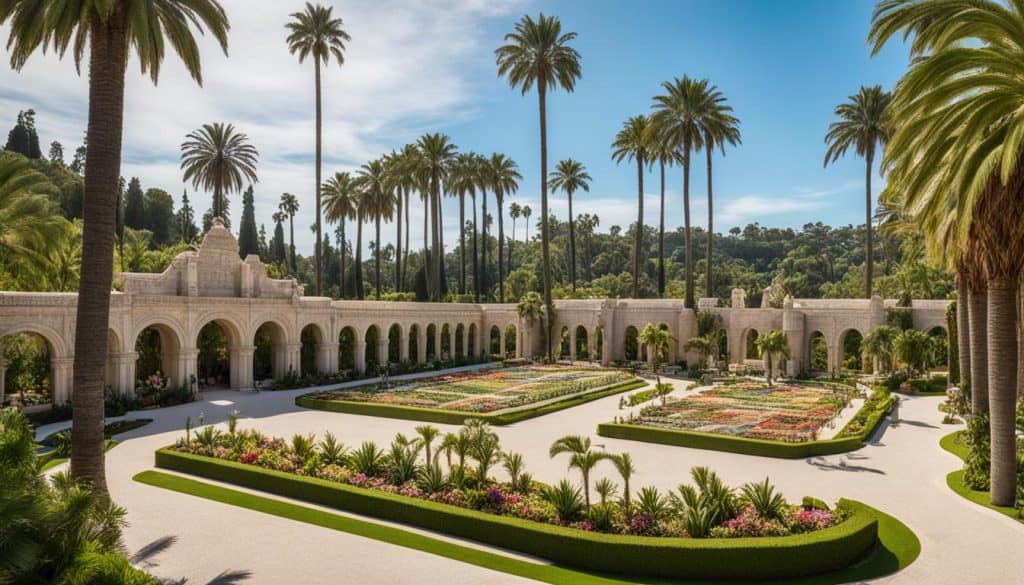
The Garden of Solomon’s Song – Romance and Beauty
In the enchanting world of biblical gardens, the Garden of Solomon’s Song stands out as a testament to romance and beauty. Inspired by the poetic verses in the Song of Solomon, this garden transports you to a realm of fragrant flowers, lush greenery, and abundant fruits. It is a place where love and passion intertwine in perfect harmony.
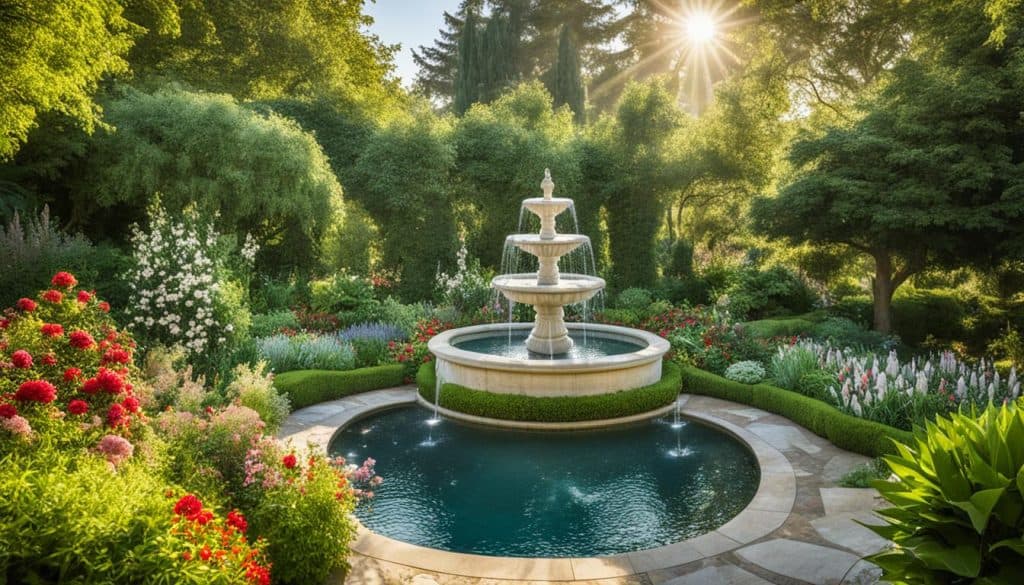
Imagine strolling along winding paths, surrounded by blooming roses, lilies, and myrrh, their intoxicating scents filling the air. The vibrant colors of the blossoms, ranging from deep crimson to pure white, create a captivating tapestry of nature’s beauty.
“Arise, my love, my beautiful one, and come away, for behold, the winter is past; the rain is over and gone. The flowers appear on the earth, the time of singing has come, and the voice of the turtledove is heard in our land.” – Song of Solomon 2:10-12
The garden echoes the passionate verses of the Song of Solomon, which celebrate the love between a bride and her beloved. It is a place where couples can find solace, serenity, and inspiration, immersed in the enchanting atmosphere created by the garden’s meticulously designed beauty.
As you explore the Garden of Solomon’s Song, you’ll come across an abundance of fruits, each carrying its symbolic meaning. From luscious pomegranates, representing fertility and abundance, to sweet dates, symbolizing love and passion, these fruits add depth and richness to the romantic ambiance.
“Come to your garden, my sister, my bride; I gather my myrrh with my spice, I eat my honeycomb with my honey, I drink my wine with my milk. Eat, friends, drink, and be drunk with love.” – Song of Solomon 5:1
The Garden of Solomon’s Song is a place where couples can escape the outside world and indulge in moments of intimacy, rejuvenation, and spiritual connection. It is a reminder of the power and beauty of love, an oasis of serenity amidst the chaos of life.
Experience the Garden of Solomon’s Song
To truly appreciate the romance and beauty of the Garden of Solomon’s Song, you need to experience it firsthand. Take a moment to immerse yourself in this idyllic garden of biblical times, basking in the fragrance of blossoms and the whispers of the past.
- Walk along the meandering paths, hand in hand with your loved one, and let the peaceful ambiance wash over you.
- Pause by the fragrant rose bushes, their petals delicately kissed by the morning dew, and feel the love in the air.
- Sit beneath the shade of a blossoming tree, savoring the sweet taste of fruits that evoke the essence of love and passion.
- Find a secluded spot amidst the lush greenery, where you can share whispered words of affection and create cherished memories.
The Garden of Solomon’s Song is a testament to the enduring power of love and its ability to inspire beauty. It serves as a reminder that amidst the chaos of life, there is always a place where romance blossoms, eternal and timeless.
Are the Palatial Gardens in the Bible Related to the Ancient Temple in Jerusalem?
The description of the palatial gardens in the Bible does not directly reference the ancient temple gates in Jerusalem. However, scholars believe that the grandeur and scale of the gardens may point to a connection with the temples, reflecting the opulence and splendor of these ancient architectural wonders.
The Garden of Ezekiel’s Vision – A Visionary Experience
Step into the Garden of Ezekiel’s Vision and prepare to be amazed. This biblical garden is more than just a collection of trees and flowers. It’s a place where dreams and reality converge, where your senses are awakened and your spirit is uplifted.
As you walk among the towering trees, you’ll feel a sense of renewal and life permeating the air. The flowing water, a symbol of purification and restoration, whispers melodies that resonate deep within your soul. It’s a transformative experience that will leave you feeling inspired and rejuvenated.
In this visionary garden, every tree tells a story, every flower holds a meaning. It’s a place where the past, present, and future intertwine, creating a tapestry of beauty and wisdom. As you explore, you’ll discover the significance of each element, unlocking hidden truths and gaining new insights.

